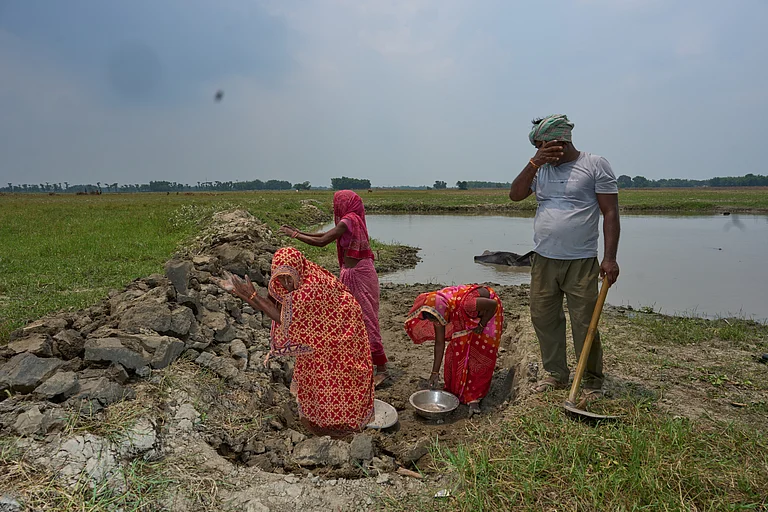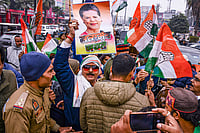A work of translation is a world recreated in another tongue. Translators who transcreate a literary text invariably slip into the style and cultural consciousness of another writer. While working with elements of sound and rhythm, image and rhetoric, tone and voice, a translator is a ventriloquist and a chameleon in his/her manipulation of language within the island of the given text and its distinct perimeter, Lydia Davis writes in Essays Two: On Proust, Translation, Foreign Languages, and the City of Arles (2021).
A translator’s identity extends well beyond a language expert. Translators are also cultural connoisseurs since they have figured out the manifold dynamics of the target literary system, remarks Hemang Ashwinkumar, a bilingual poet, translator, editor and critic, who has been working in Gujarati and English. His translation of Dalpat Chauhan’s novel, Vultures (Penguin Random House), has just been published. Centred on the violent tipping point of caste hierarchy in a Gujarat village in 1964, the novel is set to introduce English readers to one of the architects of Dalit literature in Gujarat.
ALSO READ: Let A Language Contend
In a country as linguistically diverse as India, with 22 languages listed in the officially recognised category, translation is an everyday affair. We are always in the mode to find meaning in some text or the other, written or spoken. There is a vast treasure trove of literature written in Indian languages that is waiting to be discovered by the country’s growing tribe of English speakers. In 2021, Ratno Dholi: Dhumketu’s Best Short Stories (HarperCollins India), translated by Texas-based writer, literary translator, and book critic Jenny Bhatt, was the first substantial collection of Dhumketu’s work to be made available in English. Dhumketu, the pen name of Gaurishankar Govardhanram Joshi, is widely believed to be one of the pioneers of the Gujarati short story, with an affinity towards the marginalised.

Early in April, Hindi writer Geetanjali Shree’s fifth novel, Ret Samadhi, translated into English by Daisy Rockwell as Tomb of Sand (Penguin Random House India), made it to the shortlist for the International Booker Prize. Since it’s the first novel from any Indian language to have made it to the prize for translated books (published in the UK or Ireland), the announcement, expectedly, triggered a wave of excitement. It has led to renewed interest in her work, and put the spotlight on literary translations from and within Indian languages. Shree’s novels have been extensively translated into English. They include The Roof Beneath Their Feet (HarperCollins India, 2013) and Empty Space (Seagull Books, 2017), translated by Rahul Soni and Nivedita Menon, respectively. However, it took the Booker Prize to pique the interest of Indians in Shree’s work.
Like literary awards, translations too occur in socio-political contexts and work differently in different cultural systems. “The translation culture of a country at a given time is an index of its intellect, sociology, and politics,” writes Santosh K. Sareen in his 2010 study, Translation in India: History and Politics. He argues that Hindi’s claim to have the status of primus inter pares is linked with the fact that it happens to be a language ‘spoken and understood by an arithmetically larger number of people than any other single group speaking any other Indian language’. In post-colonial India, which saw the kindling of regional linguistic pride resulting from the creation of linguistic states, English was anathema to a large number of people because it was seen as the language of the coloniser. Translators, Ashwinkumar holds, have historically withstood the pressures of poetics and ideology ruling the target culture, and brought about dynamic evolution in those literary cultures: “Literary movements, newer trends, and renaissances have been triggered in languages across the globe through cultural mediation of translators.”
Translation as a literary form has gained ground in India in the 21st century. Literary works from Hindi, Malayalam, Urdu, Kannada, Tamil, Telugu, Bangla, Marathi, and Odia are being translated into English with greater frequency. “There is certainly a greater interest in translations these days as compared to the 2000s. The steady growth in the English readership, enhanced academic and institutional attention, and globalisation have made publishers rush for their share in the market, like never before, says Ashwinkumar. What we see in terms of publication, however, is just the tip of the iceberg. “A lot of powerful literature in Indian languages remains unnoticed, untouched and untranslated, not only into English, but across Indian languages,” he adds.
Today, things have gotten better in the arena of literary translations. There are publishing imprints and literary awards exclusively for translation. Universities have courses that teach translation theory and practice. But there is something amiss. While there are more books in translation being published, the readership remains limited, as it does for literary works in general, says Rahul Soni, executive editor (Literary) with HarperCollins India, who commissions works in translation. “The attempts at bringing commercial/popular work from other languages into English have not seen huge successes largely, the audiences being vastly different. This is a long-term project though: one would hope that continued conversations about and work in the field of translation will eventually, over the years, yield results, and audiences will grow,” he adds.
There is still a long way to go, says V. Ramaswamy, who has translated the stories of Subimal Misra (The Golden Gandhi Statue from America: Early Stories, Wild Animals Prohibited: Stories, Anti-Stories, and Two Anti-Novels), Manoranjan Byapari’s The Runaway Boy, and co-translated late Bangladeshi author Shahidul Zahir’s (Life and Political Reality: Two Novellas), all from Bengali to English. “While translation and translators have become more high profile and the reading of translations has become somewhat trendy in niche circles around the world, today, even the English-speaking world is still largely ignorant about most of the important Indian writers. But the process has begun,” he says. Ramaswamy considers India to be the ultimate land for translation and hopes that through translation endeavours, translatability and translation will evolve and advance.
Days after the announcement of the International Booker Prize longlist, Frank Wynne, the first translator to be on its jury, urged publishers to pay translators royalties on the sales of books they translate, which the Booker Foundation promptly endorsed. Rockwell’s experience in this regard has been fairly good. She was offered royalties on her books with Penguin India and holds the copyright of the translated work, even though her name did not appear on the covers of the first four titles with Penguin. They include translations of Khadeeja Mastoor’s Aangan (The Women’s Courtyard) and Upendranath Ashk’s classic novel, Girti Deevarein (Falling Walls). She got the royalty and the copyright for Tomb of Sand, published by Tilted Axis Press in the UK, which was founded by International Booker Award-winning translator Deborah Smith. “As a translator herself, Deborah makes sure to treat translators well,” Rockwell says.
Ramaswamy says he recognises the fact that not all publishers can pay in advance: “When I think it is important for a work to be published, and if I respect the publisher, even though it is a small press, advance is not an issue for me.” While he would very much like translation to become financially remunerative for translators of merit, he puts the onus squarely on translators: “produce outstanding work, and claim the reward”.
Nandini Krishnan, who has translated award-winning Tamil writer Perumal Murugan’s Kazhimugam (Estuary, Westland Books, 2020), agreed to translate the two books (the other being Murugan’s Four Strokes of Luck, published by Juggernaut in 2021) because her English publishers agreed to her terms. “I have been approached by publishers, particularly from abroad, who wanted to pay me a word rate instead of royalties, and who wanted me to give up the copyright. I refused because they would never ask this of an author, and the translation is as much my baby as the original is the author’s.” For both her books, she got the translator’s credit on the cover.
Big publishers in India like Penguin Random House and HarperCollins India, follow the international norm when it comes to royalties and copyright: one-time payment for the translator, with the copyright for the translation resting with the publisher. “At HarperCollins, we have, wherever possible, tried to keep the author and translator on an equal footing—with advances and royalties split equally, and copyright for the translation resting with the translator,” says Soni. But with regional language publishers, which often struggle to stay afloat, it is not the case. “In Gujarati, one can hope for translation copyrights with certain publishers, but dreaming of royalties on sale is just futile; even authors themselves don’t dream of it,” says Ashwinkumar.
Although the Sahitya Akademi gives out annual awards for translations, the efforts of publicly-funded institutions in promoting translation amount to symptomatic gestures and window-dressing. If you want to read a Khasi or Konkani writer, for instance, you will have to look for their English translations from a commercial publisher.
The scene for translations may have evolved, but the translators are still far from receiving their due. Underscoring their role, Ashwinkumar says: “A translator literally rewrites and recreates the text, shapes it up so that it can strike root and flourish in the foreign soil. Without the significant and sincere intervention of a translator, chances are there that the source text would nosedive in the valley of oblivion and second death; for a long and meaningful ‘afterlife’ of a book, nothing short of genius would have to be commissioned.”
(This appeared in the print edition as "In Another Tongue")
ALSO READ


























